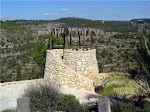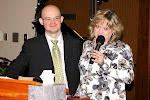 The Passover feast
commemorates the exodus of the children of Israel from the land of
Egypt and the passing over of the angel of death from the houses of
Israel who applied the blood of a lamb to the doorposts of their
house. The meal is set in an order by the Rabbis and has been this
order for several thousand years. By the reading from the books of
Matthew, Mark, Luke, and John, Yeshua (Jesus) was commemorating the Passover meal much the
same as Jewish people do in there homes every year. The order of the
service is read from the HaGadah (HA-g'DAH or also pronounced
H'GAH'dah) which means “The Telling”. It tells the story of the
exodus from Egypt by symbols.
The Passover feast
commemorates the exodus of the children of Israel from the land of
Egypt and the passing over of the angel of death from the houses of
Israel who applied the blood of a lamb to the doorposts of their
house. The meal is set in an order by the Rabbis and has been this
order for several thousand years. By the reading from the books of
Matthew, Mark, Luke, and John, Yeshua (Jesus) was commemorating the Passover meal much the
same as Jewish people do in there homes every year. The order of the
service is read from the HaGadah (HA-g'DAH or also pronounced
H'GAH'dah) which means “The Telling”. It tells the story of the
exodus from Egypt by symbols. |
| A Seder in my "Upper Room" |
 |
| Artist Unknown |
 |
| Upper room seder my house |
Now the Seder or Order which Yeshua and His disciples followed was not as elaborate as is the Seder used in traditional Judaism, today. It was compiled less than a century later. But many elements were the same as today. The Lamb, the bitter herbs, and the Matzo were a must. However, just a few decades before, the Rabbis had included the Charoset and at some point before had included the four cups of wine. We know that Yeshua probably drank the four cups of wine that were used, as Luke indicates the first cup before supper and likewise the cup after supper... Luke 22:20. The four cups of wine are linked to a passage in Exodus 6:6-7 "Wherefore say unto the children of Israel, I AM the LORD, and I will bring you out from under the burdens of the Egyptians, and I will free you out of their bondage, and I will redeem you with a outstretched arm, and with great judgments: and I will take you to me for a people, and I will be a God"
The first cup of wine is called Kadesh, which means sanctification (called out, separated). The second cup is the cup of the ten plagues. The third cup of wine is the cup of Redemption. This cup comes after the supper. Luke indicates it was this cup Yeshua was drinking when He declared, "This cup is the New Covenant in my blood, which is shed for you." Luke 22:20 Finally, the last cup of wine is called the Hallel, which means praise. It is, in fact, the Hebrew root word for Hallelujah. The tradition of singing Psalm 113-118 is customary. We find, in Matthew 26:30 & Mark 14:26, "And when they had sung a hymn, they went out into the mount of Olives." This may well have been referring to Psalms 113-118 or even to 136 which is also read on Passover.
[In the modern Seder three pieces of of matzah are placed in a three-part cloth bag called a matzah tash . Early in the service the middle piece of matzah is broken. Half is divided into large enough pieces for everyone at the table and eaten. The other half, called the afikoman, is hidden, to be found by children later and eaten by everyone as the last food of the meal. While in modern Judaism the three matzot (Plural for matzah in Hebrew) are taken as representing Priests, Levites and Israel, many scholars believe this ritual was added to the Seder service by Messianic Jews, (Jewish believers in Jesus) for whom the three matzot represent Father, Son and Holy Ghost. The second matzah - representing the Son, who called Himself the "bread of life" John 4:41;48) and who in the Matthew 26:26 says of the matzah, "This is My body" -- is broken for all and given to all (symbolically representing His death for all mankind). Yet there is a mystery, a hidden part, similar to the hidden afikoman: like the middle matzah at the Pesach meal, the Messiah appears twice in history, in a first and second coming. All these symbolisms are hidden from non-Messianic Judaism. But like the afikoman, these truths about the Messiah will eventually be found. ] Excerpt taken from Jewish New Testament Commentary, David H. Stern, 1992, pg 80



No comments:
Post a Comment